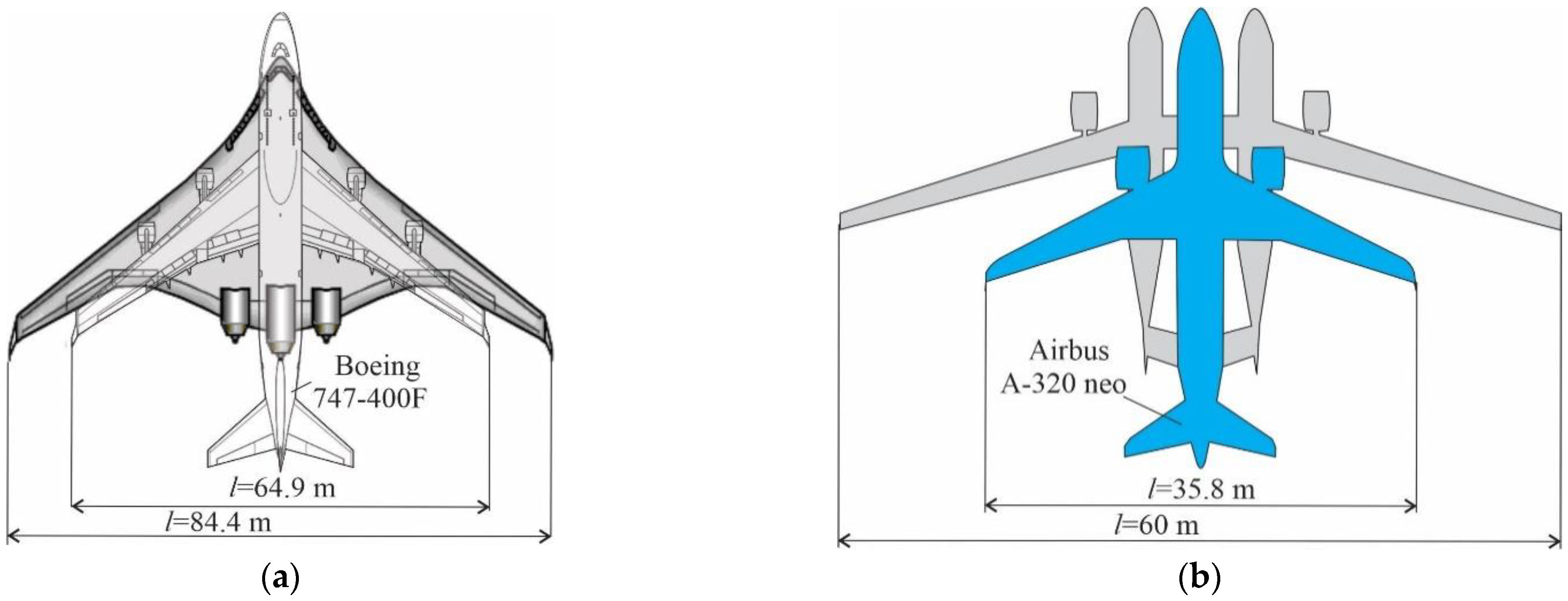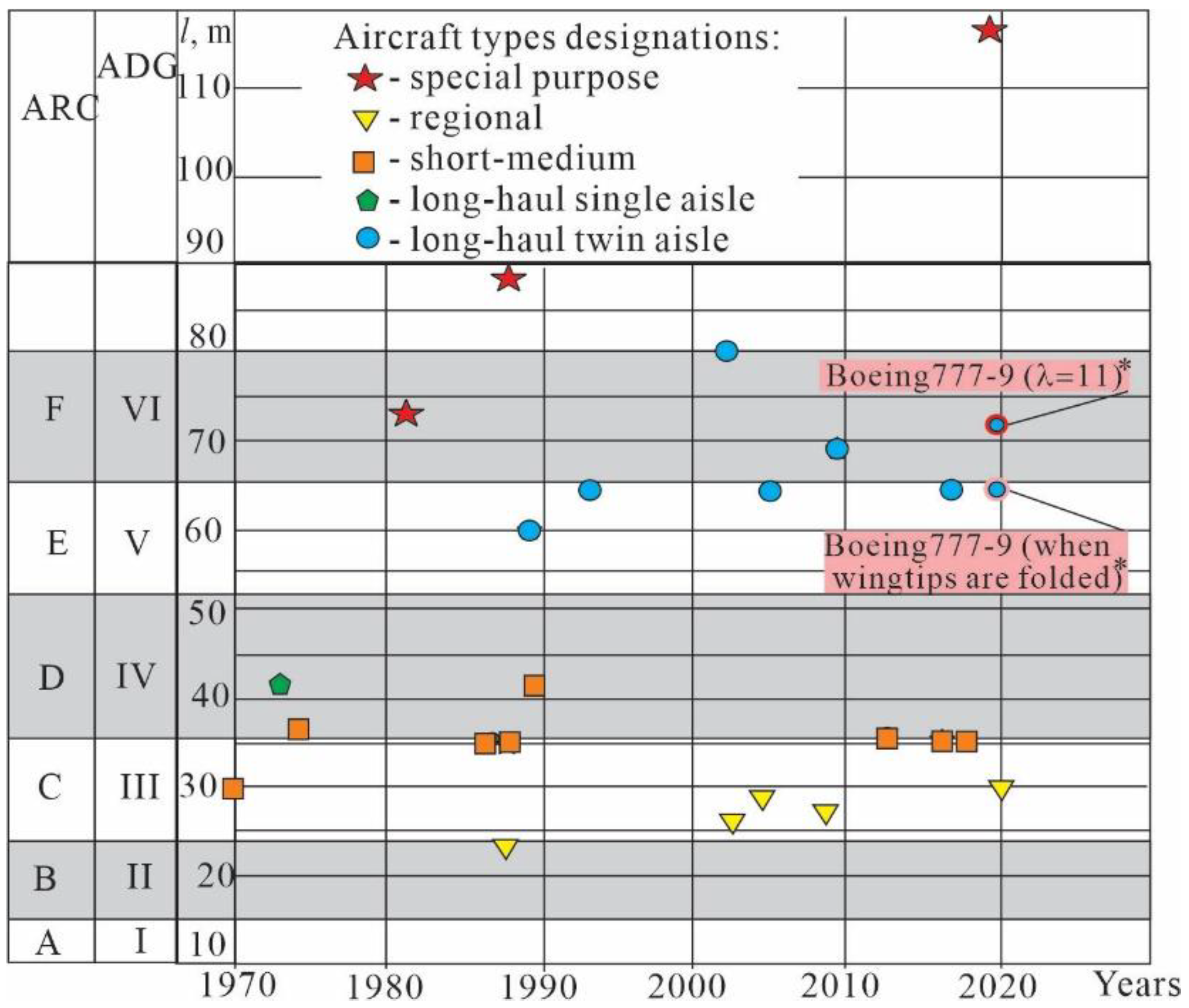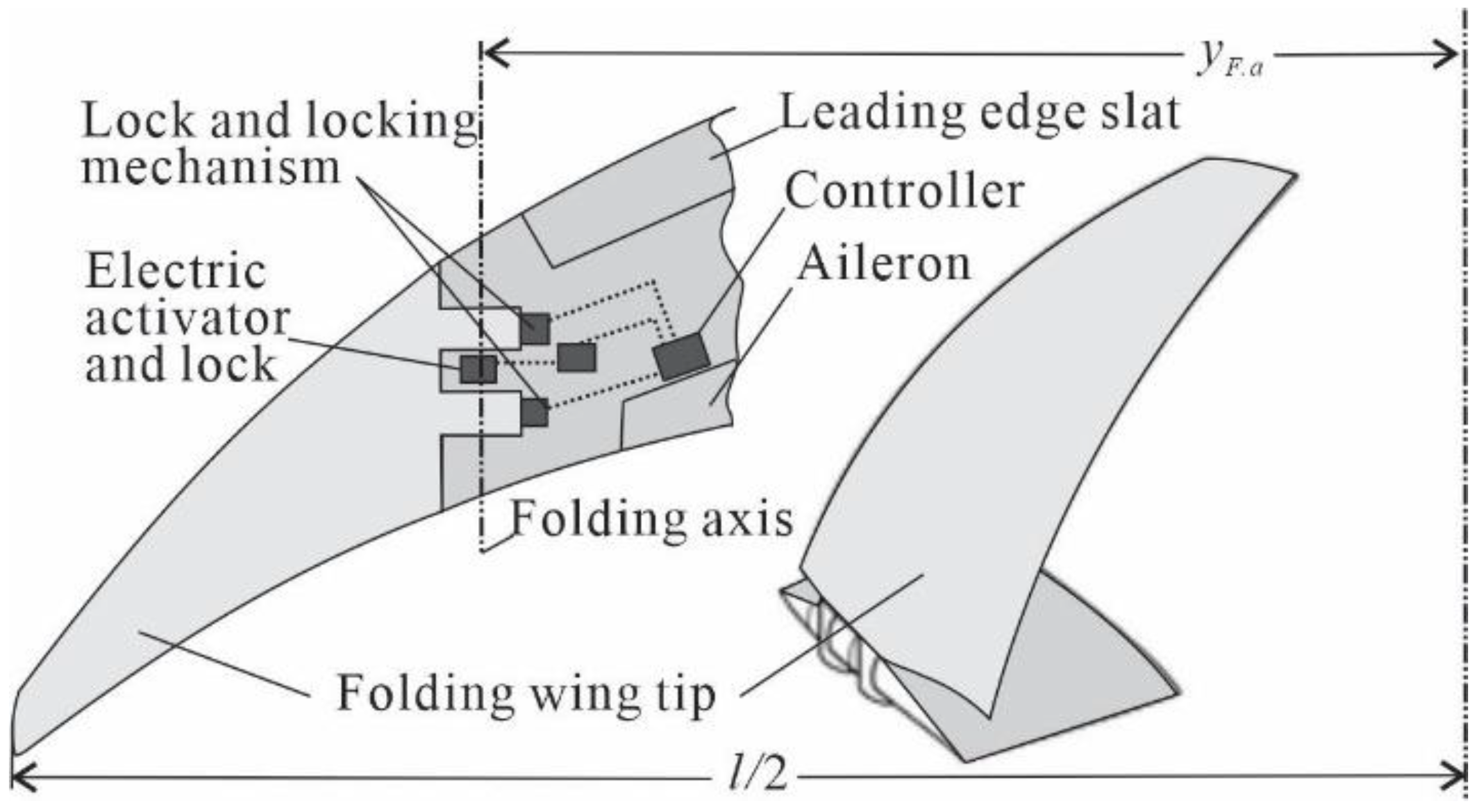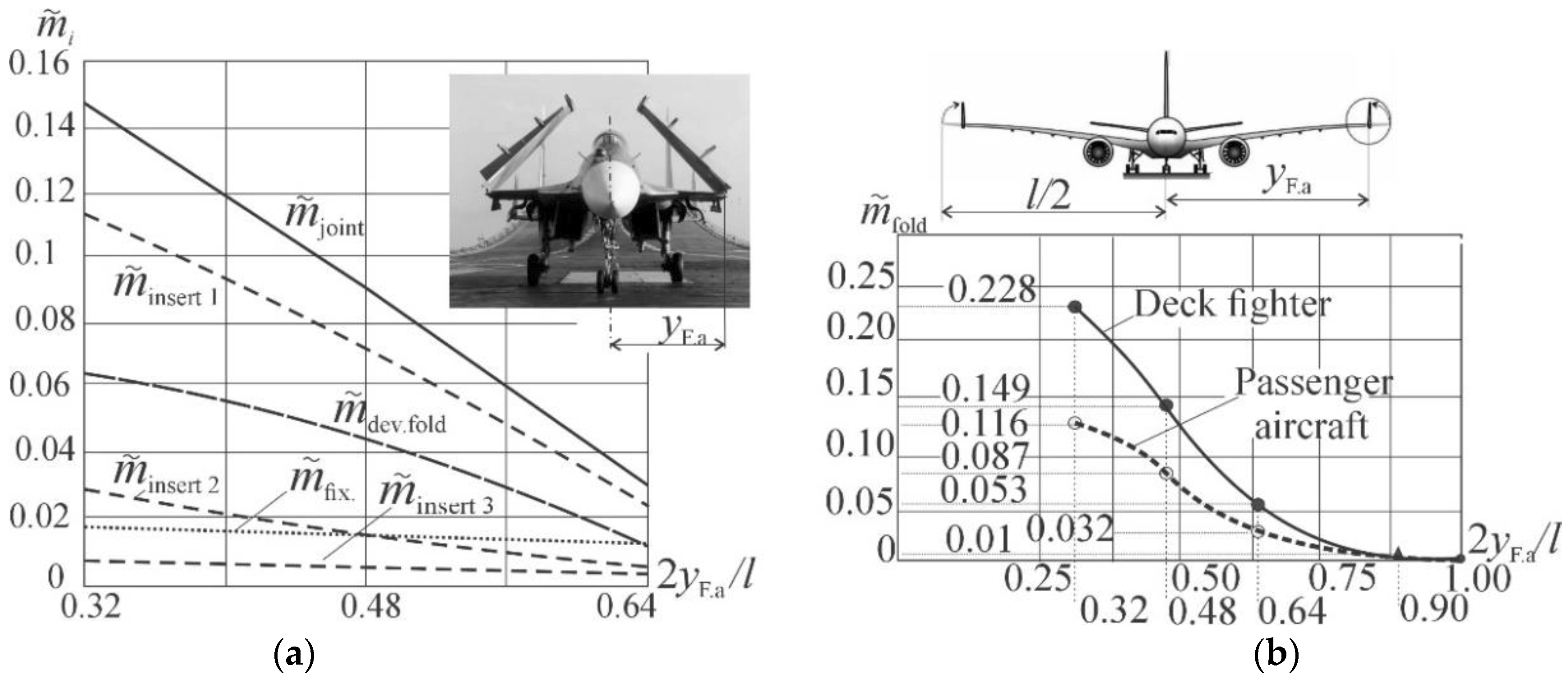Evaluation of the Mass and Aerodynamic Efficiency of a High Aspect Ratio Wing for Prospective Passenger Aircraft
Abstract
:1. Introduction
2. On Improving Fuel Efficiency
3. Impact of Parameters Changes on Maximum Takeoff Mass
4. Mass Analysis of Aircraft Structure
5. Estimation of the Mass of the Unit Providing the Wingtip Folding
6. Design Evaluation of the Effect of Aspect Ratio on Induced Drag
7. Numerical Research
7.1. Case 1. Calculation of the Coefficients SFM and
7.2. Case 2. Aerodynamic Drag and Mass Changes Estimation
8. Discussion
9. Conclusions
- Based on an interdisciplinary approach to aircraft design, a methodology for the initial assessment of the fuel efficiency of passenger aircraft with higher aspect ratio wings made of composite materials and folding wingtips was developed.
- Based on the analysis of the sensitivity of the takeoff mass of the basic aircraft to the design changes and Komarov’s universal mass equation, a new method for estimating the wing mass from composite materials was developed.
- The approach to calculating the mass of the wing tip folding unit developed for deck-based aircraft was adapted for passenger aircraft.
- The numerical fuel efficiency analysis was carried out using the proposed approach and the examples of Boeing and Airbus short-range commercial aircraft. It is shown that when transferring to wings with an aspect ratio of 11.5 made of composite materials, their fuel efficiency increases by 8–10% despite the use of folding wingtips.
Author Contributions
Funding
Institutional Review Board Statement
Informed Consent Statement
Data Availability Statement
Conflicts of Interest
Nomenclature
| CD | aerodynamic drag coefficient, |
| aerodynamic drag coefficient of the form, | |
| CD 0 | drag coefficient at zero lift force, |
| CDfus | fuselage drag coefficient, |
| CDind | induced drag coefficient, |
| CK | dimensionless factor characterizing the structure load-carrying scheme, and the nature of its loading, |
| CL | lift force coefficient, |
| CL Kmax | lift force coefficient for maximum lift-to-drag ratio, |
| ev | span efficiency factor, |
| airfoil thickness ratio, | |
| kfuel.s | mfuel.s/mfuel ratio, |
| keng.s | meng.s/meng ratio, |
| l | wingspan, |
| fuselage length, | |
| lP | reference size, |
| mDep | mass dependent on mto, |
| meng | engine mass, |
| meng.s | mass of the power plant, |
| mfuel | fuel mass, |
| mfuel.s | fuel system mass, |
| mInd | mass independent on mto, |
| mpayload | payload mass, |
| mstr | mass of the structure, |
| mtarget | target mass, |
| mto | maximum takeoff mass, |
| mwing, mfus, mtail, mlg | mass of structure units: wing, fuselage, tail and landing gear, |
| mass fraction from , | |
| mass fraction from , | |
| load factor, | |
| P | reference load, |
| p | specific wing load, |
| S | area of the wing, |
| distance from the plane of symmetry of the aircraft to the mean aerodynamic chord, | |
| the coefficient taking into account the nonstructural elements and deviation from the theoretical variant in favor of manufacturability, | |
| area of the wing, | |
| taper ratio (the ratio of tip chord to root chord), | |
| le0.25 | swept angle wing at leading edge and at 0.25 chord, |
| m | sensitivity factor of takeoff mass (SFM), |
| structural material density, | |
| U | permissible stress, |
| specific strength of the main structural material. |
References
- ICAO. Assembly Resolution on International Aviation and Climate Change (A37-19). In Proceedings of the Thirty-Fifth Session of the UNFCCC Subsidiary Body for Scientific and Technological Advice (SBSTA35), Bonn, Germany, 6–16 June 2011. [Google Scholar]
- ICAO. Present and Future Aircraft Noise and Emissions Trends Working Paper A37-WP/26. 2010. Available online: https://www.icao.int/environmental-protection/37thAssembly/wp026_en.pdf (accessed on 31 March 2022).
- Menouni, A.; Kretov, A.; Zhijin, W. Assessment of the passenger aircraft mass and efficiency with a fuselage without portholes. IOP Publishing. J. Phys. Conf. Ser. 2021, 1780, 012011. [Google Scholar] [CrossRef]
- EASA. ICAO Aircraft Engine Emissions Databank. European Union Aviation Safety Agency. 2019. Available online: https://www.easa.europa.eu/easa-and-you/environment/icaoaircraft-engine-emissions-databank (accessed on 1 March 2022).
- Seymour, K.; Held, M.; Georges, G.; Boulouchos, K. Fuel Estimation in Air Transportation: Modeling global fuel consumption for commercial aviation. Transp. Res. Part D Transp. Environ. 2020, 88, 102528. [Google Scholar] [CrossRef]
- Kretov, A.S.; Glukhov, V.V. Alternative Fuel in Transport Aviation and Estimation of Its Application Efficiency. Russ. Aeronaut. 2021, 64, 365–375. [Google Scholar] [CrossRef]
- Bicera, Y.; Dincer, I. Life cycle evaluation of hydrogen and other potential fuels for aircraft. Int. J. Hydrog. Energy 2017, 42, 10722–10738. [Google Scholar] [CrossRef]
- Verstraete, D. Long range transport aircraft using hydrogen fuel. Int. J. Hydrog. Energy 2013, 38, 14824–14831. [Google Scholar] [CrossRef]
- Hileman, J.I.; Stratton, R.W. Alternative jet fuel feasibility. Transp. Policy 2014, 34, 52–62. [Google Scholar] [CrossRef]
- Torenbeek, E. Advanced Aircraft Design: Conceptual Design, Analysis, and Optimization of Subsonic Civil Airplanes; John Wiley and Sons: Chichester, UK, 2013. [Google Scholar]
- Raymer, D.P. Aircraft Design: A Conceptual Approach, 6th ed.; AIAA: Reston, VA, USA, 2018. [Google Scholar]
- Poghosyan, M.A. Aircraft Design, 5th ed.; Innovative Engineering: Moscow, Russia, 2018. [Google Scholar]
- Val-Martinez, R.; Cuerno, C.; Perez, E.; Ghigliazza, H.H. Potential Effects of Blended Wing Bodies on the Air Transportation System. J. Aircr. 2010, 47, 1599–1604. [Google Scholar] [CrossRef]
- Chen, Z.; Zhang, M.; Chen, Y.; Sang, W.; Tan, Z.; Li, D.; Zhang, B. Assessment on Critical Technologies for Conceptual Design of Blended-Wing-Body Civil Aircraft. Chin. J. Aeronaut. 2019, 32, 1797–1827. [Google Scholar] [CrossRef]
- Okonkwo, P.; Smith, H. Review of Evolving Trends in Blended Wing Body Aircraft Design. Prog. Aerosp. Sci. 2016, 82, 1–23. [Google Scholar] [CrossRef]
- Udin, S.V.; Anderson, W.J. Wing mass formula for twin fuselage aircraft. J. Aircr. 1992, 29, 907–914. [Google Scholar] [CrossRef] [Green Version]
- Vedernikov, Y.V.; Chepiga, V.E.; Maslakov, V.P.; Kuklev, E.A.; Gusev, V.G. Configuration of the medium-haul twin-fuselage passenger aircraft. Int. J. Appl. Eng. Res. 2017, 12, 414–421. [Google Scholar]
- Ma, Y.; Elham, A. Twin-fuselage configuration for improving fuel efficiency of passenger aircraft. Aerosp. Sci. Technol. 2021, 118, 107000. [Google Scholar] [CrossRef]
- Kretov, A.S.; Glukhov, V.V. Application of Integrated Layout for “Cryogenic” Transport Category Aircraft. Russ. Aeronaut. 2022, 65, 10–24. [Google Scholar]
- Brushgens, G.S. Aerodynamic and Dynamic of Long-Haul Aircraft; TsAGI: Moscow, Russia, 1995. [Google Scholar]
- Riabkov, V.I.; Tiniakov, D.V. The method of forming the geometric parameters of lifting surfaces of aircraft transport category based on particular criteria and integral indicators of their effectiveness. J. Open Inf. Comput. Integr. Technol. Sci. Natl. Aerosp. Univ. 2011, 52, 41–48. [Google Scholar]
- Tiniakov, D.V. Integrated generation of the lift system surfaces geometric parameters on the preliminary designing stage of transport category airplanes. J. Open Inf. Comput. Integr. Technol. Sci. Natl. Aerosp. Univ. 2012, 53, 27–35. [Google Scholar]
- All the World’s Aircraft. Jane’s Publishing. Available online: https://janes.migavia.com (accessed on 11 July 2022).
- Boeing. Available online: https://www.boeing.com/777x/reveal/twitter-922798339946622976/ (accessed on 11 July 2022).
- Ballhays, W.F. Clear design thinking using the aircraft growth factor. In Proceedings of the 14th National Conference, Society of Aviation Weight Engineers, Fort Worth, TX, USA, 2–5 May 1955. [Google Scholar]
- Politkovsky, V.I.; Badyagin, A.A. On the Coefficient of Increasing the Launch Mass of the Aircraft. Izv.Vuz. Av. Tekhnika 1966, 9, 161–164. [Google Scholar]
- Ross, H. Effect of the Location of a Fixed Weight Penalty on the Aircraft Growth Factor. In Proceedings of the Social Aeronautic 28th Annual Conference, San Francisco, CA, USA, 5–8 May 1969; p. 0796. [Google Scholar]
- Gogolin, V.P. Determination of the Coefficient of Growth of Changes in Take-Off Weight During the Implementation of Changes in the Weight of the Structure. Vopr. Proekt. Letatel’nykh Appar. Tr. KAI 1973, 160, 11–15. [Google Scholar]
- Roskam, J. Airplane Design Part V: Component Weight Estimation; Roskam Aviation and Engineering Corp.: Ottawa, KS, USA, 1985. [Google Scholar]
- Hays, A.P. Zen and the art of airplane sizing. SAE Int. Paper 931255 1993, 102, 136–140. [Google Scholar] [CrossRef]
- Scholz, D. Understanding the aircraft mass growth and reduction factor. In Proceedings of the 15th European Workshop on Aircraft Design Education (EWADE 2020) and Research and Education in Aircraft Design (READ 2020), Warsaw, Poland, 21–23 October 2020; Available online: www.fzt.haw-hamburg.de/pers/Scholz/arbeiten/TextCheemaProject.pdf (accessed on 31 March 2022).
- Kretov, A. Sensitivity factors of aircraft mass for the conceptual design. J. Aircr. Eng. Aerosp. Technol. 2021, 93, 1470–1477. [Google Scholar] [CrossRef]
- Kowalski, M.; Goraj, Z.J.; Goliszek, B. The use of FEA and semi-empirical equations for weight estimation of a passenger aircraft. Aircr. Eng. Aerosp. Technol. 2021, 93, 1412–1420. [Google Scholar] [CrossRef]
- Dababneh, O.; Kipouros, T. A Review of Aircraft Wing Mass Estimation Methods. Aerosp. Sci. Technol. 2018, 72, 256–266. [Google Scholar] [CrossRef]
- Dorbath, F.; Gaida, U. Large Civil Jet Transport (MTOM > 40 t)—Statistical Mass Estimation. Luftfahrttechnisches Handbuch (LTH), 2013. Available online: https://www.lth-online.de/ueber-das-lth-informationen/lth-ausgabe.html (accessed on 31 March 2022).
- Kundu, A.K. Aircraft Design; Cambridge University Press: Cambridge, UK, 2010. [Google Scholar]
- Komarov, V.A. Mass analysis of aircraft structures: Theoretical foundations. J. Flight 2000, 1, 31–39. [Google Scholar]
- Komarov, V.A.; Weisshaar, T.A. New Approach to Improving the Aircraft Structural Design Process. J. Aircr. 2002, 39, 227–233. [Google Scholar] [CrossRef]
- Komarov, V.A.; Boldyrev, A.V.; Kuznetsov, A.S.; Lapteva, M.Y. Aircraft design using a variable density model. Aircr. Eng. Aerosp. Technol. 2012, 84, 162–171. [Google Scholar] [CrossRef]
- Komarov, V.A. Dimensionless criterion of the excellence of the power structures. J. Izv. Russ. Acad. Sci. Solid Mech. 2018, 4, 34–47. [Google Scholar]
- Kretov, A.S.; Shataev, P.A. Preliminary Assessment of the Mass of the Aircraft Fuselage as a Result of the Transition to Composite Materials. J. Russ. Aeronaut. 2020, 63, 386–396. [Google Scholar] [CrossRef]
- Awiation Week. Available online: https://aviationweek.com/commercial-aviation/boeing-777x-prototype-wingtip-tests-begin (accessed on 1 March 2022).
- Yarygina, M.V.; Popov, Y. Development of the weight formula for a folding wing. Russ. Aeronaut. 2012, 55, 120–126. [Google Scholar] [CrossRef]
- Mrazova, M. Future directions of fuel efficiency in aviation industry. INCAS Bull. 2013, 5, 71–86. [Google Scholar]
- Aircraft Technology Roadmap to 2050, IATA. Available online: https://www.iata.org/contentassets/8d19e716636a47c184e7221c77563c93/Technology-roadmap-2050.pdf (accessed on 1 March 2022).
- 777-200LR/-300ER/-Freighter; Airplane Characteristics for Airport Planning. Boeing: Arlington, VA, USA, 2015.
- 777-9; Airplane Characteristics for Airport Planning. Boeing: Arlington, VA, USA, 2018.
- Modern Airliners. Available online: https://modernairliners.com/boeing-777/boeing-777-specs/ (accessed on 1 March 2022).
- 737 MAX; Airplane Characteristics for Airport Planning. Boeing: Arlington, VA, USA, 2022.
- A320; Aircraft Characteristics. Airport and Maintenance Planning. Airbus: Blagnac, France, 2015.
- Kretov, A.; Tiniakov, D. Evaluation of Wing Structures at the Conceptual Stage of Transport Category Aircraft Project. Aviation 2022. accepted for publication. [Google Scholar]






| Parameters | S, m2 | l, m | , ° | |||
|---|---|---|---|---|---|---|
| Boeing-777-300ER | 427.8 | 64.8 | 34 | 9.82 | 0.01337 | 0.02782 |
| Boeing-777-9 | 466.8 | 71.76 | 30 | 11 | 0.01035 | 0.02416 |
| Parameters | lflight, m | lground, m | S, m2 | , ° | λ | hwinglet, m | , % | ||
|---|---|---|---|---|---|---|---|---|---|
| Boeing-737-Max 8 (Base) | 35.9 | 35.9 | 127 | 27 | 10 | 2.92 | 0.008974 | 0.0255 | – |
| Boeing-737New with new Aspect ratio | 39 | 35.9 | 132 | 27 | 11.5 | 0.007282 | 0.0236 | –7.4 | |
| Airbus A320Neo (Base) | 35.8 | 35.8 | 123 | 27 | 10.5 | 2.43 | 0.00861 | 0.0235 | – |
| Airbus A320New with new Aspect ratio | 39 | 35.8 | 132 | 27 | 11.5 | 0.00752 | 0.0225 | –4.3 |
| Parameters | (Base) | (Base) | by (13) | by (18) | , by (23) | , by (7) | by (11) | by Figure 7 | % | ||||
|---|---|---|---|---|---|---|---|---|---|---|---|---|---|
| Boeing-737-Max8 (Base) | 82.1 | 16.2 | 8.27 | – | – | – | – | – | 1.91 * | – | – | – | – |
| Boeing-737New | – | – | 9.58 | 5.84 | 1.31 | –3.74 | 0.1 | –1.2 | –6.6 | –2.18 | –7.5 | –10.7 | |
| Airbus A320 Neo (Base) | 78 | 18.9 | 7.96 | – | – | – | – | – | 1.85 * | – | – | – | – |
| Airbus A320New | – | – | 9.17 | 5.54 | 1.21 | –3.63 | 0.1 | –0.81 | –5.8 | –1.9 | –5.7 | –8.15 |
Publisher’s Note: MDPI stays neutral with regard to jurisdictional claims in published maps and institutional affiliations. |
© 2022 by the authors. Licensee MDPI, Basel, Switzerland. This article is an open access article distributed under the terms and conditions of the Creative Commons Attribution (CC BY) license (https://creativecommons.org/licenses/by/4.0/).
Share and Cite
Kretov, A.; Tiniakov, D. Evaluation of the Mass and Aerodynamic Efficiency of a High Aspect Ratio Wing for Prospective Passenger Aircraft. Aerospace 2022, 9, 497. https://doi.org/10.3390/aerospace9090497
Kretov A, Tiniakov D. Evaluation of the Mass and Aerodynamic Efficiency of a High Aspect Ratio Wing for Prospective Passenger Aircraft. Aerospace. 2022; 9(9):497. https://doi.org/10.3390/aerospace9090497
Chicago/Turabian StyleKretov, Anatolii, and Dmytro Tiniakov. 2022. "Evaluation of the Mass and Aerodynamic Efficiency of a High Aspect Ratio Wing for Prospective Passenger Aircraft" Aerospace 9, no. 9: 497. https://doi.org/10.3390/aerospace9090497







